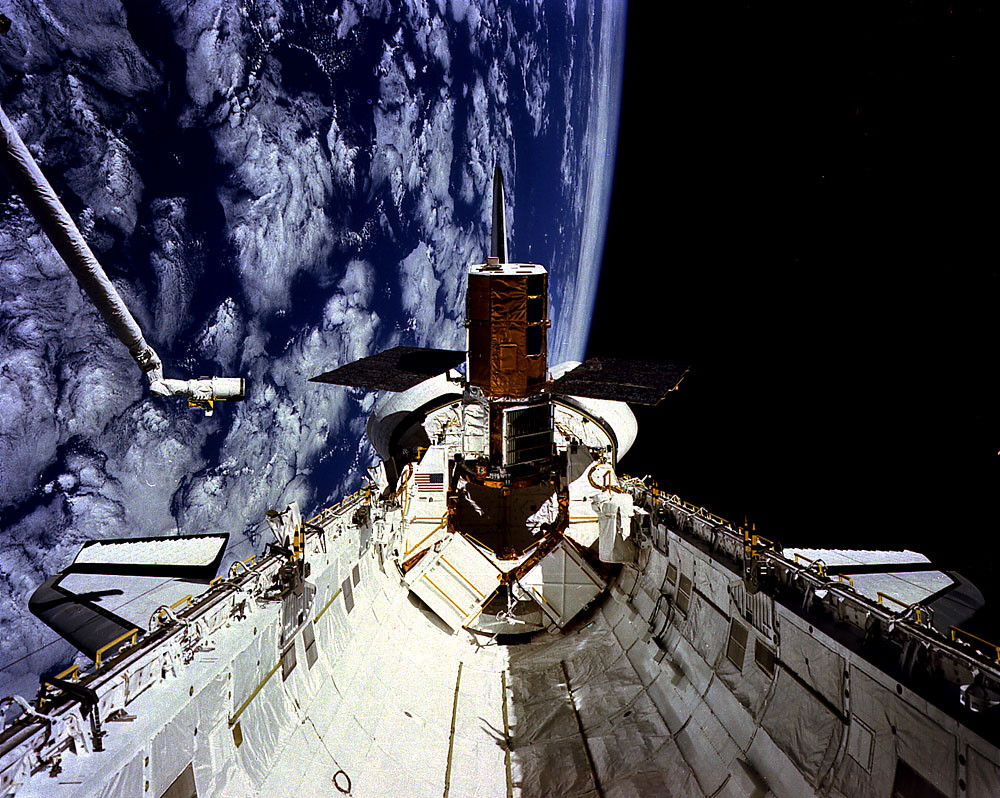
Thirty years ago today (6 April 1984), the shuttle launched on arguably its most ambitious mission to date: a mission which would demonstrate the reusable orbiter’s capabilities of rendezvous, retrieval, satellite repair, and spacewalking with the Manned Maneuvering Unit (MMU) “jet backpack” in spectacular fashion and enhance NASA’s confidence in anticipation of future flights to service the Hubble Space Telescope (HST). Originally designated “STS-13,” and later redesignated “STS-41C,” the reader would be forgiven for thinking that the mission might have been dogged with ill-fortune. In fact, for the five-man crew, the question of good or bad luck even factored into their impromptu mission patch. On Mission 41C in April 1984, astronauts Bob Crippen, Dick Scobee, Terry Hart, James “Ox” van Hoften, and George “Pinky” Nelson salvaged NASA’s crippled Solar Maximum Mission (SMM) spacecraft—nicknamed “Solar Max”—and after initial difficulties repaired and rejuvenated it during two magnificent EVAs.
As described in yesterday’s AmericaSpace article, the mission began with little magnificence, for spacewalker Pinky Nelson had been unable to dock his Trunnion Pin Attachment Device (TPAD) onto the slowly spinning satellite on 8 April and his actions had actually jostled it and made matters worse. It was impossible for Hart to extend the shuttle’s Canadian-built Remote Manipulator System (RMS) mechanical arm to grapple the satellite. This required 41C commander Bob Crippen to withdraw Challenger to a distance of about 100 miles (160 km), as mission managers discussed their next move.
Overnight, as the astronauts slept, engineers at NASA’s Goddard Space Flight Center in Greenbelt, Md., which operated the satellite, battled to regain control, but since its solar panels were no longer pointing toward the Sun, battery power was gradually dwindling away without recharging. The engineers switched off as many systems as possible, including heaters, but still had only six to eight hours of battery life left. When it became clear that Solar Max’s magnetic torque bars were now slowing the rotation, Goddard implemented a new technique, using a different method of sensing its position. This made the bars more effective in “pushing off” against Earth’s magnetic field, and the satellite quickly stabilized itself. Then, just as battery life was running out, it came around in its orbit in such a way that the electricity-generating panels faced sunward once more and began to recharge. When the crew awoke on the morning of 9 April, the satellite’s batteries were powered and it was rotating serenely at half a degree per second.
Fuel reserves in Challenger’s propellant tanks were low, at 13 percent, prompting Bob Crippen to quip that it really was STS-13 now! “Then we talked about what we had to do and Mission Control worked out the available fuel,” said Terry Hart in a NASA oral history interview, “but we took an extra day and decided we would do a second rendezvous. This time, Pinky and Ox would stay inside the orbiter and I would try to capture it with the arm.” It also became clear during the second spacewalk precisely why Nelson’s attempts to capture Solar Max had been thrice frustrated: a small grommet, just 0.8 inches (20 mm) high and 0.25 inches (6.4 mm) thick, had obstructed the full penetration of the TPAD onto the satellite’s trunnion pin. The grommet, which was installed near the pin, helped to hold part of Solar Max’s gold-colored thermal insulation blanket in place.
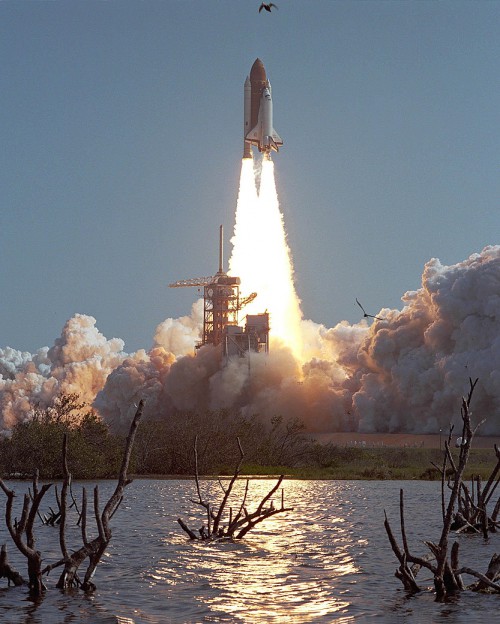
“What no-one noticed,” explained Hart, “is that one of the blankets had been put on with a little fiberglass standoff that the grommets would fit over. The engineering drawings didn’t specify where those standoffs could be, so when they assembled the satellite, the technicians just put one wherever the grommet was. They glued it onto the metal frame, then stuck the blanket on. That was the correct thing to do, because no-one envisioned using that pin for anything.” A use for the pin did emerge, however, a year after Solar Max’s launch, when the option of a shuttle repair was first explored in depth, “but when they were designing the TPAD,” Hart continued, “no-one noticed that there was a grommet there. When Pinky went to dock, it interfered with the docking adaptor.”
It turned out that, if Nelson had made his approach to the pin within a very narrow pitch angle “corridor,” he might have succeeded and captured Solar Max. However, during his second EVA, he took measurements of where the grommet was and the obstruction it posed, and found that it stuck out 0.6 inches (1.5 cm) too far. The TPAD, clearly, would not work. Either way, Challenger’s on-board fuel was now too low to support a rescue if Nelson’s MMU happened to fail. Instead, Crippen would fly close enough to Solar Max for Hart to grapple it with the mechanical arm.
Early on 10 April, on his first attempt, Hart successfully grappled the Solar Max satellite with the RMS and anchored it onto a Flight Support Structure (FSS) at the rear end of the payload bay. “It was a dramatic moment for Mission Control,” he remembered later. “We were euphoric when we succeeded. We really felt that the mission was at risk, which it was, and we were really on a mission that was demonstrating the flexibility and usefulness of the Shuttle to do things like repair.”
The spectacular success, sadly, would prove to be the MMU’s death knell.
An umbilical line was connected to the satellite to feed it with power from the orbiter, and it was pivoted around so that Nelson and van Hoften, during their second spacewalk, which began at 3:58 a.m. EDT on 11 April, could reach and fix its broken attitude control system and the main electronics box of the disabled coronagraph and polarimeter. These repairs were originally meant to occupy one EVA apiece, but with the condensed and rescheduled flight plan it was decided to attempt both during the same excursion. Replacement of the attitude control box, which had been responsible for crippling the $240 million project more than three years earlier, took just 45 minutes.
Standing on the end of the RMS, his feet anchored in restraints, van Hoften removed a pair of screws, pulled the box out smoothly, and plugged in a new unit. The second procedure of fixing the main electronics box to the coronagraph and polarimeter, which was not designed for replacement in orbit, was expected to be a longer and trickier task. Nonetheless, with surprising dexterity and outstanding skill, van Hoften pulled back a panel covering the box, cut and taped back a layer of insulation, removed two dozen screws, and cut several wires. Nelson then took over, installing the new electronics box using large, gold-plated beryllium clips, instead of tiny screws, for the connectors. An hour after their second task had begun, the two men were finished and were able to place a baffle cover over the X-ray polychromator to vent its exhaust gases away from Solar Max’s other instruments.
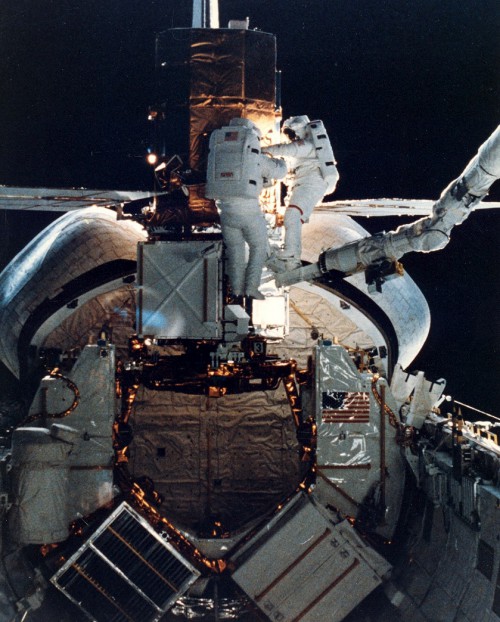
The second EVA had lasted six hours and 44 minutes, which, together with their two-and-a-half-hour outing on 8 April, brought Nelson and van Hoften’s spacewalking time to more than nine hours. “The repair itself was a kick,” Pinky Nelson recalled years later. “It was so much easier to work in space than it is on the ground. Ox and I, and T.J. Hart running the arm, just kind of did this repair. It was a piece of cake! It was so much fun riding on the end of the arm and much easier than working underwater.” The pilots, too, were just as excited, particularly Scobee, who persuaded his crewmates to don T-shirts for the space-to-ground press conferences, emblazoned with the legend, Ace Satellite Repair Company.
Finally, after a day of checkout in the payload bay, on 12 April 1984 Hart grappled the satellite with the RMS and deployed it back into space. By this time, in view of the additional day of planning needed to retrieve Solar Max, the mission had been extended by 24 hours and rescheduled to land on “unlucky” Friday, 13 April, after all. Yet, despite the huge success of the repair, bad luck had one more card to play. Much to Crippen’s chagrin, the planned landing at the Kennedy Space Center (KSC) was postponed and finally cancelled due to showers in Florida, obliging the crew to land at Edwards Air Force Base.
For Terry Hart, who had already decided before the mission that this would be his only space mission, the re-entry came after a sleepless last night in orbit, soaking up as much of the experience as possible. Pinky Nelson, who had ridden into orbit on the middeck, changed places with Hart on Challenger’s flight deck for the return to Earth. “I didn’t have a lot of time, since we were busy on the flight, but the last night on-orbit, I had no duties at all,” recalled Hart. “I just figured that I wasn’t going to sleep at all. I’d turned down a second mission [the Spacelab-D1 flight] and was going back to AT&T Corporation, so I was damned if I was going to sleep. I stayed up all night and looked out the window while the rest of the crew was sleeping and watched the Himalayas go by and other parts of the world that I didn’t see during the regular shifts.”
Re-entry the following morning, he remembered, “was a wonderful thing. Watching the fireball around the vehicle was breathtaking. The engineer side of me wanted to see the G build-up, but I had a camera and remember just letting it go and it would sit there, of course, when we were weightless. As we started to hit the upper parts of the atmosphere, I watched the camera accelerate forward as I let go, because the vehicle was decelerating. I was downstairs, but I was able to stick my head up every once in a while before I strapped in and looked out and could see the fireball overhead ‘flickering,’ a very impressive experience coming through that, but very smooth and quiet all the way down.”
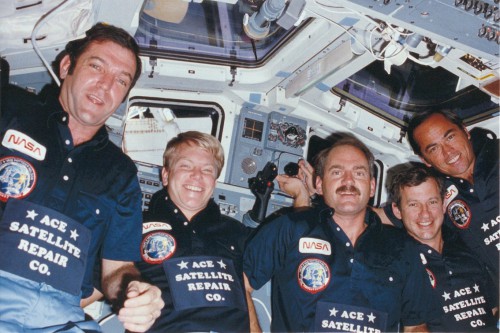
True to the weather forecasters’ predictions, an ominous thunderstorm arrived over KSC’s Shuttle runway at precisely the time that Bob Crippen might otherwise have been landing there. “My family were in Cape Canaveral,” continued Hart, “and we were landing in California, but it was beautiful. When I got out of my seat, I felt like I was using almost all of my strength just to get up! I was used to moving my body around with just my fingertips and now, all of a sudden, I had to exert all this force to get up. We didn’t want to fall down the stairs on national television, so we were all doing deep knee bends to make sure we got our blood flowing again.” Van Hoften, in the flight engineer’s seat, recalled watching the effects of the super-heated plasma, whilst Nelson’s enduring memory was how strong the sense of gravity felt on his body after a week of weightlessness. Yet Crippen’s touchdown was perfect. “I’d done so many approaches and landings in the simulator, the Shuttle Training Aircraft and the T-38 jets,” Nelson said, “that the landing felt very normal. It was disappointing that my family could not be there.”
Challenger made landfall at 5:38:06 a.m. PDT (8:38:06 a.m. EDT) on the Edwards dry lakebed, Runway 17, completing a mission of almost exactly seven days. As 41C’s epic voyage ended, Solar Max’s rejuvenated voyage of exploration had scarcely begun. After a four-week checkout, it set to work on what would turn into more than five years of observations of changes in the Sun’s energy output. Its coronagraph and polarimeter, repaired by Nelson and van Hoften, resumed work in June 1984 and, despite a few interruptions, continued to capture images of the solar corona during the “daytime” portions of the satellite’s orbit until the end of the mission. Minor problems arose for most of January 1986, when Solar Max suffered a loss of memory in its on-board computer. Observations were again interrupted in December of that year, when the coronagraph’s dedicated tape recorder failed, only coming back online in March 1987, thanks to the use of a backup device. Nevertheless, the satellite continued operating—in spite of atmospheric friction gradually dragging its orbit downward—almost until the end of the decade.
Other scientific results included the surprising discovery that the Sun is much brighter during periods at which “sunspot” activity on its surface reaches its peak. Solar Max’s instruments confirmed that, although the sunspots themselves are dark, they are surrounded by bright “faculae,” which more than offset the dimming effects of these Earth-sized blotches. By the time the satellite’s mission ended in mid-November 1989, just two weeks before it re-entered the atmosphere, it had chalked up an impressive tally of a quarter of a million images of the Sun’s corona and over 12,000 recorded solar flares. Additionally, its gamma ray spectrograph made important contributions to the international study of Supernova 1987A, which had provided astronomers with their first “local” opportunity to examine such a major stellar event since 1604. It also detected 15 observed gamma ray bursts from deep space.
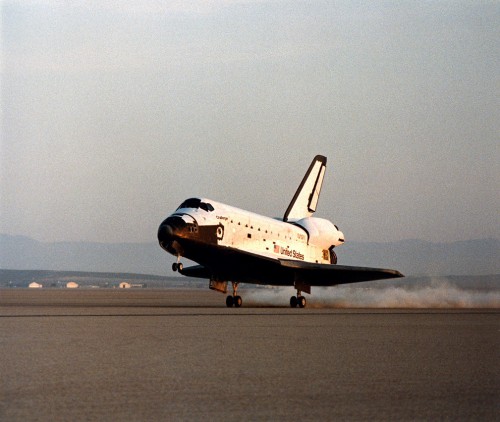
If Mission 41C was stricken with bad luck at all, the greatest victim must have been the MMU jet backpack first tested by Bruce McCandless two months earlier. Admittedly, it had performed admirably and could hardly be blamed directly for the failure of the TPAD. Indeed, it would prove its worth in November 1984 when, flown by Joe Allen and Dale Gardner, it was instrumental in the retrieval of the errant Palapa-B2 and Westar-6 communications satellites. However, what 41C did prove was the crisp maneuverability of the orbiter itself and the precise handling characteristics of the RMS. It was, observers said later, Hart’s small grab, rather than Nelson’s free flight, which had pulled success from the jaws of what might have been an ignominious defeat.
In the fall of 1989, there was an effort to fly the MMU again. A proposal was solicited from Martin Marietta for recertification and refurbishment for one shuttle mission. It came in at $6.1 million, which was deemed too expensive, and despite some small sums for clean room environmental storage, “just in case,” they were eventually retired. Today, the MMU flight unit first used by Bruce McCandless hangs in the Smithsonian. The other backpack was loaned to NASA’s Marshall Space Flight Center in Huntsville, Ala., for possible future use as a “flying testbed” for autonomous rendezvous and docking systems. Both units were mothballed until such time as their unique capabilities were needed again.
They never were.
Perhaps, through the drawbacks it uncovered with the multi-million-dollar backpack, 41C proved to be an unlucky mission after all.
This is part of a series of history articles, which will appear each weekend, barring any major news stories. Next week’s article will focus on the anniversary of Yuri Gagarin’s pioneering voyage into space on 12 April 1961, which began humanity’s exploration beyond our planet.
Want to keep up-to-date with all things space? Be sure to “Like” AmericaSpace on Facebook and follow us on Twitter: @AmericaSpace




Thank you for the auspicious writeup. It inn truth was a entertainment account it.
Glance advanced to more deliveered agreeable from you!
By thhe way, hoow can we keep up a correspondence?